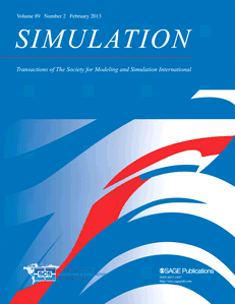
SIMULATION-TRANSACTIONS OF THE SOCIETY FOR MODELING AND SIMULATION INTERNATIONAL
Scope & Guideline
Unleashing the Power of Simulation for Real-World Impact
Introduction
Aims and Scopes
- Modeling Methodologies:
The journal emphasizes various modeling techniques, including agent-based modeling, system dynamics, discrete-event simulation, and hybrid modeling approaches that integrate multiple methodologies for enhanced simulation accuracy and functionality. - Application Domains:
Research published in the journal spans multiple domains such as healthcare, transportation, urban planning, energy systems, and environmental studies, showcasing how simulation can address real-world challenges across different sectors. - Simulation Optimization:
The journal highlights the importance of simulation optimization techniques that aim to improve decision-making processes by finding optimal solutions in complex systems, often involving stochastic elements. - Interdisciplinary Approaches:
A consistent focus on interdisciplinary research is evident, where modeling and simulation techniques are applied to various scientific and engineering challenges, fostering collaboration between fields. - Emerging Technologies:
The journal explores the integration of emerging technologies such as artificial intelligence, machine learning, and digital twins into simulation practices, driving innovation and enhancing the capabilities of simulation tools.
Trending and Emerging
- Digital Twins and Cyber-Physical Systems:
There is a growing emphasis on the concept of digital twins and their applications in monitoring and optimizing physical assets. This trend signifies a shift towards integrating real-time data into simulation processes. - AI and Machine Learning Integration:
The incorporation of artificial intelligence and machine learning techniques into simulation practices is increasingly prevalent, enabling more adaptive and intelligent modeling solutions. - Resilience and Crisis Management:
Research focusing on resilience and crisis management simulations has gained traction, particularly in response to global challenges such as pandemics and natural disasters, emphasizing the journal's role in addressing urgent societal issues. - Sustainability and Environmental Modeling:
Emerging themes around sustainability and environmental modeling are prominent, reflecting growing concerns about climate change and the need for simulations that support ecological and resource management. - Complex Systems and Interdisciplinary Collaborations:
There is a notable trend towards studying complex systems and fostering interdisciplinary collaborations, indicating a recognition of the interconnectedness of various fields and the complexity of the issues they address.
Declining or Waning
- Traditional Simulation Techniques:
There is a noticeable decline in papers focusing solely on traditional simulation techniques without the integration of newer methodologies or technologies, indicating a shift towards more complex and hybrid approaches. - Purely Theoretical Models:
Research that centers exclusively on theoretical models, without practical applications or empirical validation, is becoming less common, as the journal increasingly favors studies demonstrating real-world applications. - Low-Complexity Systems:
The focus on low-complexity systems has diminished, with fewer studies addressing simple simulations. Instead, the trend is leaning towards more sophisticated models that capture the complexities of real-life scenarios.
Similar Journals
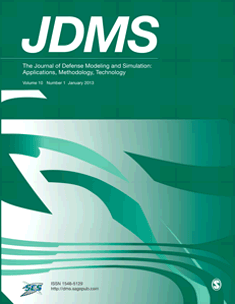
Journal of Defense Modeling and Simulation-Applications Methodology Technology-JDMS
Exploring New Frontiers in Defense Technology and ApplicationsThe Journal of Defense Modeling and Simulation: Applications Methodology Technology (JDMS), published by SAGE Publications Inc, is an esteemed platform dedicated to advancing the field of defense modeling and simulation. Established in 2004, this journal has become a vital resource for researchers, practitioners, and students engaged in engineering and modeling disciplines, as evidenced by its Q2 rank in Engineering (miscellaneous) and Q3 in Modeling and Simulation categories in the 2023 metrics. With an ISSN of 1548-5129 and an E-ISSN of 1557-380X, JDMS features cutting-edge methodologies and applications that enrich the technological landscape essential for modern defense operations. Although it is not an Open Access journal, it continues to foster knowledge sharing through rigorous peer-reviewed articles. By bridging theoretical advancements with practical applications, JDMS plays a critical role in promoting innovation and collaboration in the defense sector, making it a must-read for those committed to pushing the boundaries of this dynamic field.
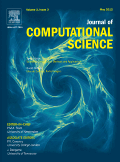
Journal of Computational Science
Catalyzing Discoveries in Modeling and SimulationThe Journal of Computational Science, published by Elsevier, is a premier academic journal that serves as a vital platform for researchers and professionals in the fields of computer science, modeling, and simulation. With an ISSN of 1877-7503 and an E-ISSN of 1877-7511, this journal focuses on the latest advances in computational methodologies and their applications, fostering interdisciplinary dialogue and collaboration. As of 2023, it holds an impressive Q2 ranking in multiple categories, including Computer Science (miscellaneous), Modeling and Simulation, and Theoretical Computer Science, showcasing its relevance and impact within the scholarly community. The journal features comprehensive research articles, reviews, and case studies that contribute significantly to the understanding and development of computational techniques. With its high standing in Scopus rankings, including a 79th percentile ranking in Mathematics - Modeling and Simulation, the Journal of Computational Science is an essential resource for anyone seeking to advance their knowledge and research in this dynamic field.

JOURNAL OF COMPUTING AND INFORMATION SCIENCE IN ENGINEERING
Exploring Innovations at the Intersection of Science and TechnologyWelcome to the JOURNAL OF COMPUTING AND INFORMATION SCIENCE IN ENGINEERING, a premier publication from ASME that focuses on the dynamic intersection of computing and engineering disciplines. With an ISSN of 1530-9827 and E-ISSN 1944-7078, this journal serves as a critical platform for disseminating innovative research and advancements in areas such as Computer Graphics, Computer-Aided Design, Software Engineering, and Industrial Manufacturing. The journal spans from 2001 to 2024 and has been recognized for its excellence, boasting impressive Scopus rankings including Q1 in Industrial and Manufacturing Engineering and Q2 in both Computer Graphics and Computer Science Applications. It offers a unique opportunity for researchers, professionals, and students to engage with high-impact studies and present their contributions to a diverse audience. As a member of the esteemed ASME family, this journal promotes open dialogue and fosters the growth of knowledge in technical fields, while emphasizing practical applications and interdisciplinary collaboration. Join us in exploring the forefront of computing and engineering through rigorous research and insightful articles that drive innovation and progress.
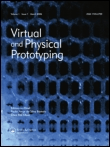
Virtual and Physical Prototyping
Innovating Design Through Cutting-edge ResearchVirtual and Physical Prototyping is a premier scholarly journal published by Taylor & Francis Ltd, which has established itself as a leading platform for innovative research in the fields of Computer Graphics, Computer-Aided Design, Industrial and Manufacturing Engineering, Modeling and Simulation, and Signal Processing. Since its inception in 2006, the journal has gained significant recognition, currently ranked in the Q1 quartile in multiple categories, reflecting its high impact and rigorous standards of scholarship. Now an Open Access journal as of 2023, it provides a unique opportunity for researchers, professionals, and students to share their work widely and engage with a global audience. With its strategic emphasis on the convergence of virtual and physical prototyping technologies, this journal contributes vital knowledge and insights that drive innovation and development in manufacturing processes and design methodologies. Located in the United Kingdom, its comprehensive approach to both theoretical and practical aspects of prototyping ensures that it remains an essential resource for advancing the respective fields it represents.
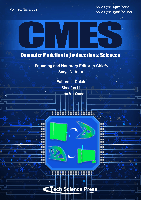
CMES-COMPUTER MODELING IN ENGINEERING & SCIENCES
Enhancing Knowledge through Open Discourse and ResearchCMES-COMPUTER MODELING IN ENGINEERING & SCIENCES is a premier journal published by Tech Science Press, dedicated to advancing knowledge in the fields of computer science applications, modeling and simulation, and software engineering. With an impressive convergence of research from 2000 to 2024, this journal stands out as a vital resource for researchers, professionals, and students alike, fostering innovation and collaboration in computational methodologies. The journal currently holds a Q3 category ranking in multiple disciplines according to the latest metrics, including Scopus, which reflects its growing significance in the academic community. By providing a platform for high-quality research and open discourse, CMES aims to enhance the understanding of complex systems through effective modeling techniques and computational tools. Despite its current classification under open access, the journal remains a cornerstone for those looking to deepen their expertise in cutting-edge computational engineering and science.

Radio Electronics Computer Science Control
Advancing Knowledge in Radio Electronics and Control SystemsRadio Electronics Computer Science Control is a distinguished academic journal published by the ZAPORIZHZHYA NATIONAL TECHNICAL UNIVERSITY that has been committed to advancing the fields of radio electronics, computer science, and control systems since its inception in 1999. With an open access model, the journal ensures that high-quality research is freely available to a global audience, fostering collaboration and innovation among researchers, professionals, and students alike. While the current impact factor is not listed, the journal remains an essential resource for those seeking to explore cutting-edge developments in technology and engineering, contributing significantly to the interdisciplinary dialogue among scholars in these domains. The journal publishes original research articles, reviews, and case studies, making it a vital platform for disseminating knowledge and advancing scientific understanding in the rapidly evolving landscape of computer and control systems. Located in Zaporizhzhya, Ukraine, the journal serves as a beacon of scholarly communication in Eastern Europe and beyond.
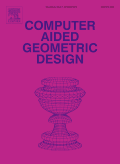
COMPUTER AIDED GEOMETRIC DESIGN
Empowering Innovation in Aerospace and Automotive DesignCOMPUTER AIDED GEOMETRIC DESIGN is a premier journal dedicated to the interdisciplinary field of geometric design, showcasing cutting-edge research that intersects with Aerospace Engineering, Automotive Engineering, and Computer Graphics. Published by ELSEVIER in the Netherlands, this esteemed journal has maintained its relevance and impact since its inception in 1984, with a converged publication strategy continuing through 2024. Currently categorized in Q2 across multiple domains, including Aerospace Engineering and Computer-Aided Design, it reflects a solid standing within the academic community. Researchers can access high-quality articles, contributing to the advancement of applied mathematics and simulation methodologies. Despite not being an open-access journal, it offers significant insights that support innovation in design processes, making it a vital resource for academics, professionals, and students aiming to deepen their understanding and explore new possibilities in geometric design and related fields.

Computation
Unlocking the potential of applied mathematics and computer science.Computation, published by MDPI, is an esteemed open-access journal that has been contributing to the fields of applied mathematics and computer science since its inception in 2013. With an E-ISSN of 2079-3197, this Swiss-based journal operates under a philosophy of free knowledge dissemination, allowing researchers, professionals, and students globally to access high-quality content without financial barriers. Recognized for its rigorous peer-review process, Computation is currently categorized in the Q2 and Q3 quartiles across significant domains, including Applied Mathematics (#181/635), Theoretical Computer Science (#52/130), and Modeling and Simulation (#138/324). As it converges towards 2024, the journal continues to attract innovative and impactful research aimed at advancing theoretical frameworks and practical applications within these disciplines. Joining the Computation community not only enriches individual research portfolios but also contributes to the broader conversation on computational methodologies and their applications in solving real-world problems.

Quantitative Biology
Exploring the Intersection of Numbers and NatureQuantitative Biology is a prestigious journal published by WILEY, focusing on the interdisciplinary study of quantitative approaches in the biological sciences. With an ISSN of 2095-4689 and an E-ISSN of 2095-4697, this journal has established itself as a critical platform for researchers exploring complex biological systems through mathematical and computational methodologies. Operating out of China, Quantitative Biology significantly contributes to its field, holding a Q2 ranking in various categories, including Applied Mathematics and Biochemistry, Genetics and Molecular Biology, according to the latest Scopus rankings. These rankings reflect the journal's commitment to publishing high-quality research that employs advanced modeling and simulation techniques. The journal's impact is evident with its position in the 84th percentile for Applied Mathematics, indicating its relevance and growth in a competitive academic landscape. Although it does not currently operate under an Open Access model, the journal is pivotal for professionals and students alike, aiming to bridge the gap between mathematical theories and biological applications. Researchers are encouraged to submit their innovative findings and engage with the vibrant community dedicated to advancing the quantitative understanding of biological phenomena.
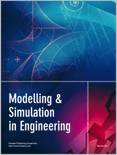
Modelling and Simulation in Engineering
Exploring New Frontiers in Modeling and SimulationModelling and Simulation in Engineering is a pioneering open-access journal, published by HINDAWI LTD, and established in 2007. With a focus on advancing the fields of engineering, computer science applications, and modeling and simulation, this esteemed journal serves as a vital platform for researchers, professionals, and students alike. The journal has made significant strides in its academic contributions, reflected in its current categorization within the Q3 quartile in Computer Science Applications, Engineering (miscellaneous), and Modeling and Simulation as of 2023. With a Scopus ranking of 133 out of 307 in General Engineering and 183 out of 324 in Mathematics' Modeling and Simulation, it emphasizes the crucial interplay between theoretical research and practical applications. Each article published in Modelling and Simulation in Engineering undergoes a rigorous peer-review process, ensuring high-quality research dissemination. By maintaining an open-access format, the journal promotes global collaboration and accessibility, supporting the dissemination and advancement of engineering knowledge worldwide. With its headquarters located in the United States, the journal is truly positioned at the convergence of innovation and research.